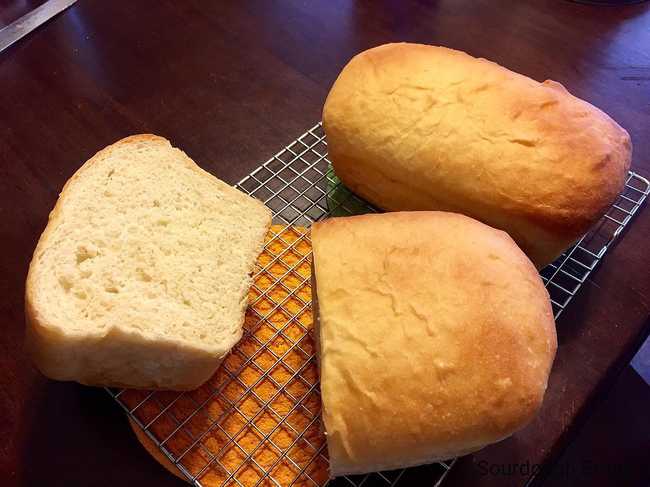Sourdough Bread I
Sourdough bread is a type of bread that is made with a sourdough starter. A sourdough starter is a mix of flour and water that contains wild yeast and bacteria. The wild yeast and bacteria give the bread its sour flavor.
Ingredients
- 1 cup sourdough starter,
- 1½ cups warm water,
- 1½ teaspoons salt,
- ½ cup white sugar,
- ½ cup corn oil,
- 6 cups bread flour
Instructions
In a large bowl, mix together the sourdough starter, warm water, salt, sugar, and corn oil. Sift in the bread flour and stir until well combined. Grease or oil your hands and shape the dough into a ball. Place the dough in an oiled bowl, cover, and let rise overnight.
The next day, knead the dough for 10 minutes. Divide it in half and shape each half into a loaf. Place the loaves on greased baking sheets and let them double in size.
Bake at 350 degrees Fahrenheit for 40 to 45 minutes, or until the bread is golden brown and sounds hollow when tapped. Turn out onto wire racks to cool completely before slicing and serving.”
Nutrition Facts
- Serving size: 1 slice (1/12 of recipe)
- Calories: 190
- Fat: 5 g
- Saturated fat: 0.5 g
- Unsaturated fat: 4.5 g
- Trans fat: 0 g
- Cholesterol: 0 mg

Is sourdough a healthy bread?
Sourdough is a healthy bread because it contains a variety of vitamins and nutrients that are beneficial to your day-to-day health. Sourdough bread has small to moderate amounts of iron, manganese, calcium, B1-B6, B12, folate, zinc, potassium, thiamin, niacin, riboflavin, selenium, magnesium, phosphorus and vitamin E. All of these vitamins and minerals are essential for maintaining good health and preventing various diseases.
For example, the iron in sourdough bread helps prevent anemia by transporting oxygen to the cells in our body. The calcium helps keep our bones strong and the B vitamins help convert food into energy. The zinc helps boost our immune system while the selenium protects our cells from damage.
So as you can see, sourdough bread is not only delicious but also packed with nutrients that are essential for good health.
Is sourdough bread better for you than white or wheat bread?
For many years, white bread has been the go-to choice for sandwich bread or toast. However, in recent years, sourdough bread has become a popular alternative – and for good reason! Although it may not look very different from regular white or wheat bread, sourdough is actually a healthier option in several ways.
One of the main benefits of sourdough is that it is more digestible than other types of bread. This is because it contains lower levels of phytates, which are compounds that can interfere with the absorption of nutrients. Additionally, the prebiotics in sourdough help to keep gut bacteria healthy and may also help to regulate blood sugar levels.
What is sourdough bread made of?
Sourdough bread is made of flour, water, Lactobacillus bacteria and wild yeasts. The mixture of bacteria and wild yeast is called a sourdough starter. It’s made by mixing flour and water and letting it sit until microbes move in and ferment it.
The Lactobacillus bacteria produces lactic acid, which gives sourdough bread its distinctive tangy flavor. The wild yeasts also contribute to the flavor of the bread, as well as providing leavening power. When the dough is mixed and left to rise, the yeast cells produce carbon dioxide gas, which makes the dough light and airy.
Sourdough bread has been around for thousands of years. It was probably first made by accident when some flour came into contact with wild yeast spores (which are everywhere in the environment). Once people realized that this combination could be used to make bread that was both delicious and had a longer shelf life than unfermented dough, they began culturing their own starters from scratch.
Today, you can still find sourdough starters being passed down from generation to generation in families who have been making sourdough bread for centuries. You can also buy starters from specialty bakeries or online retailers.
Is sourdough bread healthier for you?
There is no doubt that sourdough bread is healthier for you than regular white or whole wheat bread. Although it has comparable nutrients, the lower phytate levels mean it is more digestible and nutritious. The prebiotics also help to keep your gut bacteria happy, and it may be less likely to spike blood sugar levels.
Sourdough bread has been around for centuries, and was even used as a medical treatment in ancient Greece. In recent years, science has begun to catch up with what our ancestors knew all along – that sourdough is good for you!
So what makes sourdough so special? Let’s take a closer look at some of the key benefits:
1) Sourdough is more digestible than other types of bread. This is because the fermentation process breaks down the gluten proteins into smaller fragments which are easier for our bodies to absorb. This is especially beneficial for people who are sensitive to gluten or have celiac disease. 2) Sourdough contains lower levels of phytic acid than other types of bread. Phytic acid can bind to essential minerals like iron and calcium, making them unavailable to our bodies. This means that sourdough Breads are more nutrient-rich than other types of breads.3) The prebiotics in sourdough help keep your gut bacteria happy! Prebiotics are a type of dietary fiber that acts as “food” for probiotic (good) bacteria in our guts.
What is the healthiest bread?
There are many types of bread, and each has different health benefits. Sprouted whole grain bread is made from whole grains that have started to sprout from exposure to heat and moisture. This type of bread is high in fiber and nutrients, and it can help regulate blood sugar levels. Sourdough bread is made with a fermentation process that breaks down the gluten, making it easier to digest. 100% whole wheat bread is also high in fiber and nutrients, but it does contain gluten. Oat bread is a good source of soluble fiber, which can help lower cholesterol levels. Flaxbread is high in omega-3 fatty acids, which are beneficial for heart health. 100% sprouted rye bread contains no gluten and is rich in vitamins and minerals. Healthy gluten-free breads are available that are made with alternative flours such as rice or tapioca flour.
So what is the healthiest type of bread? It really depends on your individual needs and preferences. If you have celiac disease or are sensitive to gluten, then a healthy gluten-free option would be best for you. Otherwise, any of the above mentioned types of bread would be a good choice for maintaining good health.




